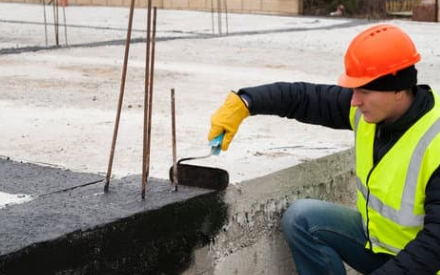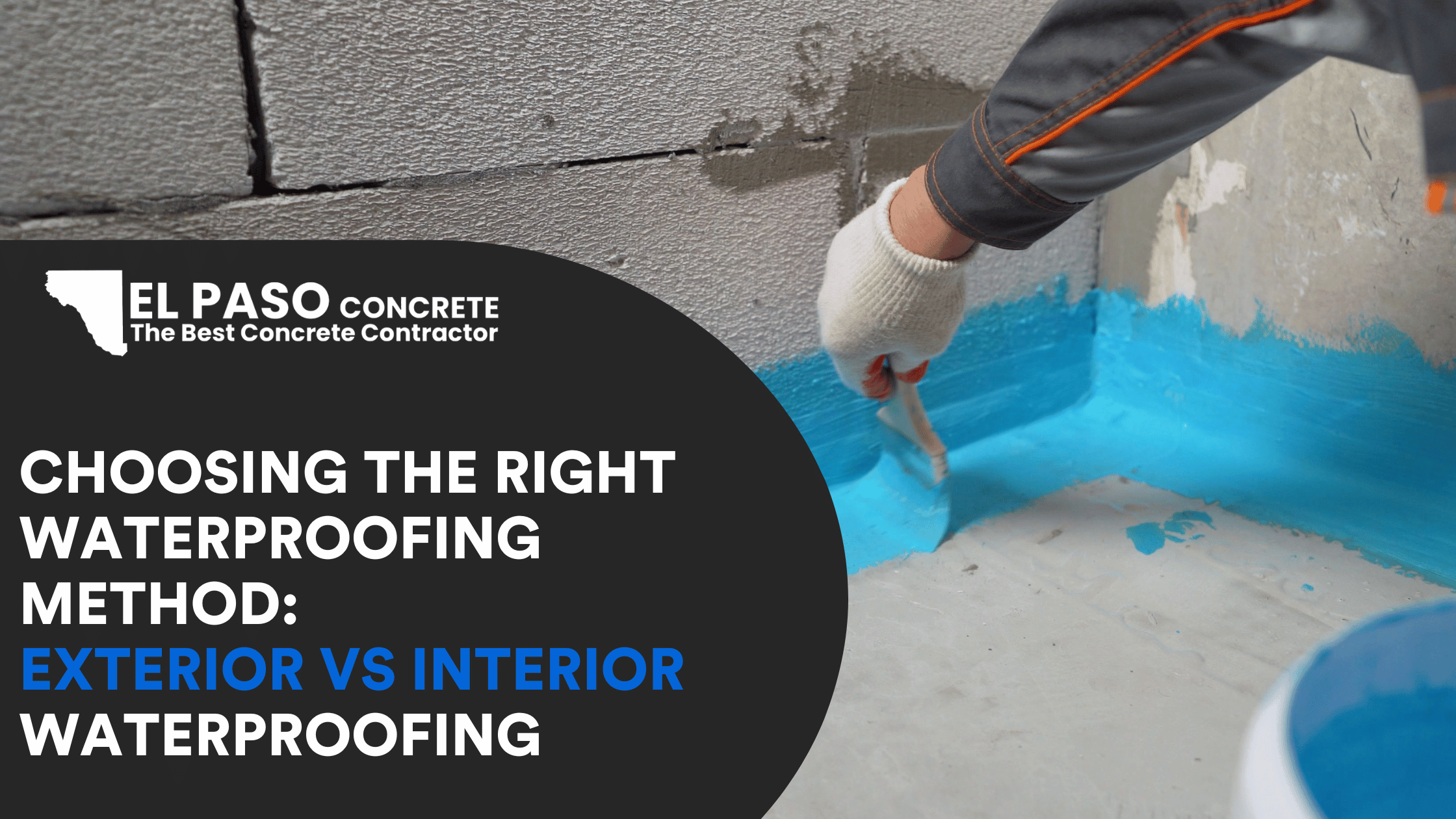Is your basement often damp and saturated? Are you worn out from constantly battling stubborn mold? Persistent water seepage in your basement can undoubtedly be exhausting. But don’t worry! We’re here to assist you in addressing waterproofing concerns by presenting possible solutions for this ongoing issue. We’ll help you figure out whether internal or external waterproofing is the right solution for your basement.
Introduction to Exterior and Interior Waterproofing Methods
When it comes to protecting your basement against water damage, choosing the right waterproofing method is crucial. Both exterior and interior waterproofing methods play a significant role in preventing water infiltration and preserving the structural integrity of your home’s foundation.
Exterior waterproofing involves creating a barrier on the outside of your basement walls to prevent water from seeping in. This method is highly effective in stopping water intrusion and preventing potential structural damage. However, it can be costly and require extensive excavation work.
On the other hand, interior waterproofing focuses on managing water that has already entered the basement. This method includes installing an interior drainage system, such as a sump pump, to redirect water away from the foundation. Interior waterproofing is often more affordable and less disruptive, making it a popular choice for cost-conscious homeowners.
The decision between exterior and interior waterproofing depends on several factors, including the severity of the water problem, budget constraints, and preservation of aesthetics. It’s essential to consult a trusted waterproofing contractor who can assess your specific needs and provide a cost estimate for each method.
In the following sections, we will explore the pros and cons of both exterior and interior waterproofing methods, helping you make an informed decision to ensure a dry and protected basement.
Exterior Waterproofing: Pros and Cons

Exterior waterproofing methods provide a robust defense against water intrusion and can significantly enhance the longevity of your basement walls and the overall structural integrity of your home’s foundation. However, it’s important to consider both the advantages and disadvantages of this approach before making a decision.
Advantages of Exterior Waterproofing:
1. Superior Protection: Exterior waterproofing creates a highly effective barrier against water infiltration. By addressing the problem at its source, this method prevents water from reaching the basement walls, thereby minimizing the risk of structural damage.
2. Long-Term Solution: With the proper installation of exterior waterproofing systems, you can enjoy long-lasting protection against water damage. It is a proactive measure that offers peace of mind, knowing that your basement is safeguarded from potential issues caused by water infiltration.
3. Preserves Interior Space: By waterproofing the exterior of your basement walls, you can maintain the full usable space within your basement. Unlike interior waterproofing, which may encroach upon valuable square footage, the exterior method does not impact the interior aesthetics or limit your design options.
Disadvantages of Exterior Waterproofing:
1. Higher Cost: Exterior waterproofing generally requires more extensive work, including excavation, installation of drainage systems, and sealing the exterior walls with a waterproof membrane. Due to the labor-intensive nature of this method, it tends to be more expensive compared to interior alternatives.
2. Time-Consuming Installation: The implementation of exterior waterproofing can be a time-consuming process. Excavation, trenching, and other related tasks may result in disruption to your property during installation. Factors such as soil conditions and the complexity of the project can further extend the installation duration.
3. Limited Accessibility: If your home is surrounded by landscaping, hardscaping, or other structures, accessibility to the exterior foundation walls can be restricted. This may lead to additional challenges and costs associated with the excavation process.
It is crucial to evaluate these pros and cons in the context of your specific needs, budget, and the severity of the water infiltration problem. Consulting with a trusted waterproofing contractor can provide valuable insights and a cost estimate to help you determine whether exterior waterproofing is the better method for your basement.
Remember, selecting the appropriate waterproofing approach is an essential part of ensuring the long-term protection and preservation of your home’s foundation.
Interior Waterproofing: Pros and Cons
Interior waterproofing methods offer several benefits when it comes to dealing with existing water issues in your basement. However, it is important to understand their limitations and potential drawbacks as well. Let’s explore the pros and cons of interior waterproofing to help you make an informed decision.
Pros
1. Effectively deals with existing water issues: Interior waterproofing methods such as interior drainage systems and sump pump installations are highly effective in managing water infiltration and preventing basement flooding. These systems help to redirect water away from the foundation, ensuring a dry and safe basement environment.
2. Cost-effective upfront: Interior waterproofing tends to be relatively more cost-effective compared to exterior waterproofing methods. This is because it involves less extensive excavation work and can be completed without disrupting the landscape around your home. If you’re a cost-conscious homeowner, interior waterproofing may be a more budget-friendly option.
3. Addresses hydrostatic pressure: Interior waterproofing methods are designed to handle hydrostatic pressure, which occurs when water builds up around the foundation of your home. By installing an interior drainage system, you can effectively mitigate pressure and prevent structural damage to your basement walls.
Cons
1. Does not address the root cause: Unlike exterior waterproofing, which tackles water infiltration at its source, interior waterproofing methods primarily focus on managing water already inside the basement. While these methods can help prevent further damage, they do not address the underlying issues that may be contributing to the water intrusion.
2. May affect indoor air quality: Interior waterproofing methods often involve sealing basement walls with a waterproof membrane or using high-quality waterproof sealants. While this helps to keep water out, it can also restrict the natural diffusion of moisture. This can potentially lead to poor indoor air quality or the formation of toxic mold if ventilation is inadequate.
3. Temporary solution for external factors: Interior waterproofing methods are effective in managing water issues caused by internal factors. However, if you have poor exterior drainage or a high water table in your area, interior waterproofing may only provide a temporary solution. External factors can still pose a risk, and addressing them may require a combination of interior and exterior waterproofing methods.
As with any basement waterproofing approach, it is important to consult with a trusted waterproofing contractor to assess your specific needs and determine the best course of action. Remember, each basement has its own unique construction and requirements, so there is no one-size-fits-all solution.
Core Differences Between Exterior and Interior Waterproofing
When it comes to waterproofing your basement, there are two main methods to consider: exterior waterproofing and interior waterproofing. While both methods are effective in preventing water damage, they have distinct differences in terms of efficiency, protection intensity, cost, and installation time.
Efficiency: Exterior waterproofing provides a more comprehensive level of protection against water infiltration. By applying a waterproof membrane to the exterior walls of the basement, it creates a barrier that prevents moisture from seeping through. On the other hand, interior waterproofing focuses on managing existing water issues inside the basement rather than preventing them from occurring in the first place.
Protection Intensity: Exterior waterproofing offers stronger and long-lasting protection for your basement walls. It addresses the root causes of water infiltration, such as poor drainage systems and hydrostatic pressure. In contrast, interior waterproofing acts as a secondary line of defense against water intrusion by installing an interior drainage system and sump pump to redirect water away from the basement.
Cost: Exterior waterproofing is generally more expensive due to the labor-intensive process involved in excavating the foundation and applying the waterproofing membrane. On the other hand, interior waterproofing is often a more cost-effective upfront solution, especially for cost-conscious homeowners. However, it’s important to consider the long-term costs of potential water damage repairs if interior waterproofing is not sufficient.
Installation Time: Exterior waterproofing requires more time and labor due to the excavation process. This can cause disruption to your landscaping and may take several weeks to complete. Interior waterproofing, on the other hand, can be completed relatively quickly, usually within a few days.
It’s crucial to consult with a trusted waterproofing contractor to assess the specific needs of your basement. Factors such as the severity of the water problem, your budget, preservation of aesthetics, and future home value should all be considered when determining the best approach. Remember, both exterior and interior waterproofing methods have their own advantages and limitations, so it’s essential to choose the method that aligns with your specific needs for long-term protection against water damage.
Choosing the Right Method for Your Basement
When it comes to waterproofing your basement, choosing the right method is crucial for long-term protection against water damage. As a homeowner, you need to consider several factors to determine whether exterior or interior waterproofing is the best approach for your specific needs.
Severity of the Problem
Assess the severity of the water infiltration in your basement. If you have visible cracks and leaks in the foundation walls or excessive water seeping through, exterior waterproofing may be the more effective solution. On the other hand, if the water issues are minor or confined to specific areas, interior waterproofing could suffice.
Budget Considerations
Consider your budget when making a decision. Exterior waterproofing tends to be more expensive due to the extensive excavation and installation process. If you’re cost-conscious and have budget constraints, interior waterproofing methods like interior drain systems or crack injections may be more affordable options.
Preservation of Aesthetics
Exterior waterproofing can alter the appearance of your home’s exteriors, as it involves excavation and installation of external drainage structures. If you’re concerned about preserving the aesthetics of your home, interior waterproofing methods that don’t require extensive excavation or construction may be preferable.
Future Home Value
Think about the impact of your waterproofing choice on the future value of your home. Exterior waterproofing can be seen as a proactive measure by potential buyers, assuring them of a dry basement and foundation stability. Interior waterproofing, while effective in addressing existing water issues, may not have the same perceived value in terms of long-term protection.
By considering the severity of the water problem, budget constraints, preservation of aesthetics, and future home value, you can determine whether exterior or interior waterproofing is best for your basement. It’s advisable to consult with a trusted waterproofing contractor who can assess your specific situation and provide a cost estimate for each method. Remember, choosing the right method now can save you from potential structural damage and costly repairs in the future.
Conclusion
In conclusion, when it comes to waterproofing your basement, choosing the right method is crucial for long-term protection against water damage. Both exterior and interior waterproofing methods have their pros and cons.
Exterior waterproofing is highly effective at preventing water infiltration and can provide a high level of protection. However, it can be costly and time-consuming to install, especially in century-old homes with complex foundation structures.
On the other hand, interior waterproofing methods are more cost-effective upfront and can effectively address existing water issues. However, they may not provide the same level of protection against external water intrusion.
Ultimately, the choice between exterior and interior waterproofing depends on factors such as the severity of the problem, budget, preservation of aesthetics, and future home value. It is important to consult with a trusted waterproofing contractor to assess your specific needs and provide a cost estimate for each method.
Selecting the appropriate waterproofing method is essential for maintaining a dry and structurally sound basement, protecting your home’s foundation, and preventing costly repairs in the future.

